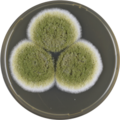| Aspergillus pseudocaelatus | |
|---|---|
| Scientific classification | |
| Kingdom: | Fungi |
| Division: | Ascomycota |
| Class: | Eurotiomycetes |
| Order: | Eurotiales |
| Family: | Aspergillaceae |
| Genus: | Aspergillus |
| Species: | A. pseudocaelatus |
| Binomial name | |
| Aspergillus pseudocaelatus Varga, Frisvad & Samson, 2011 [1] | |
Aspergillus pseudocaelatus is a species of fungus in the genus Aspergillus . It was first isolated from an Arachis burkartii leaf in Argentina. It is most related to the non-aflatoxin producing Aspergillus caelatus , producing aflatoxins B and G, as well as cyclopiazonic acid and kojic acid. [1]

